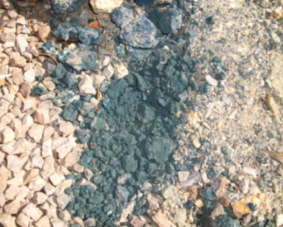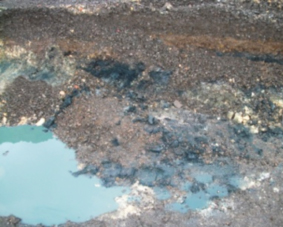 Contaminated Soils and Soil Sampling
Contaminated Soils and Soil Sampling
Do you know what contaminants are in the soil you are digging or working with?


We were recently involved in a project where the contractors excavating soil on a site came across an area that had a definite blue tinge to it.
Sampling and analysis confirmed that it was heavily contaminated with cyanide.
The implications of finding this cyanide contamination were serious. There is a potential health risk to workers on site and also a risk to landfill workers and the general environment if it was not treated properly.
Luckily for all involved those in charge stopped and took samples before it went too far.
Contaminated soil is soil that contains human made chemicals that have been released into the natural soil environment.
Soil contamination/pollution is typically caused by:
- the use of pesticides
- the rupture of underground fuel tanks
- oil and fuel dumping
- percolation of contaminated surface water to subsurface strata
- the leaching of wastes from landfill
- or the direct discharge of industrial waste to the soil.
The migration of contaminants through soils and groundwater can also cause problems on sites adjacent to the original point of contamination.
It is important that soil testing is carried out well in advance of excavation works (read why in a true story here). This will allow you to make decisions on what you need to do before works start on site. The aim of the sampling is to determine the levels and types of contaminants present. The two main reasons you need to know this are:
1. To classify the soil as either a ‘fill material’ or contaminated and the category of contamination.
This is important in determining the correct method of disposal. In Victoria generally there is Category A, B and C for soils but other factors such as being asbestos, explosives, infectious, flammable or reactive with air and water also need to be taken into account. The various states have different requirements for classifying waste so check with your local authority before starting.
2. To determine the potential health risk to people working on or in the vicinity of the contaminated soil.
Even if you are not planning on removing and disposing of the soil you need to know the levels and nature of contaminants so that you can make an informed decision on the potential health effects to workers and other site users. The acceptable safe levels may also vary depending on the proposed use of the site. For example, the accepted safe levels of some contaminants are lower for a Kindergarten development site than for a factory site.
Remediation
Methods of contaminated soil remediation can include:-
- Removal to land fill,
- Aeration of soils (turning over soil stockpile over several months),
- Thermal remediation (introduce heat to volatise chemical contamination),
- Bioremediation (microbial digestion of certain organic chemicals),
- Containment (capping or paving over in place), and
- Phytoremediation (use of plants to extract contaminants)
Depending on the site location, the level of contamination and proposed remediation activities, you may be expected to develop an approved Site Remediation Management Plan. This would incorporate Remediation Action Plan detailing the remediation activities to be undertaken and an Environmental Management Plan which would address all environmental issues.
In any remediation works you need to take into account a number of important issues during the remediation processes. These can include:
- Air quality – dust, odours, gases
- Surface and runoff water
- Ground water
- Soil quality
- Noise caused by remediation activities
- Other issues such as vibration, effects of de-watering etc
- Impact on flora and fauna
- Heritage issues
- Social aspects – how it will be perceived by local residents or users of the area
- Occupational Health & Safety of those undertaking remediation works and also those working near or visiting the area
- Security of the site
- Intended use of the site after remediation.